
- Bioactive Compounds
- By Signaling Pathways
- PI3K/Akt/mTOR
- Epigenetics
- Methylation
- Immunology & Inflammation
- Protein Tyrosine Kinase
- Angiogenesis
- Apoptosis
- Autophagy
- ER stress & UPR
- JAK/STAT
- MAPK
- Cytoskeletal Signaling
- Cell Cycle
- TGF-beta/Smad
- Compound Libraries
- Popular Compound Libraries
- Customize Library
- Clinical and FDA-approved Related
- Bioactive Compound Libraries
- Inhibitor Related
- Natural Product Related
- Metabolism Related
- Cell Death Related
- By Signaling Pathway
- By Disease
- Anti-infection and Antiviral Related
- Neuronal and Immunology Related
- Fragment and Covalent Related
- FDA-approved Drug Library
- FDA-approved & Passed Phase I Drug Library
- Preclinical/Clinical Compound Library
- Bioactive Compound Library-I
- Bioactive Compound Library-II
- Kinase Inhibitor Library
- Express-Pick Library
- Natural Product Library
- Human Endogenous Metabolite Compound Library
- Alkaloid Compound LibraryNew
- Angiogenesis Related compound Library
- Anti-Aging Compound Library
- Anti-alzheimer Disease Compound Library
- Antibiotics compound Library
- Anti-cancer Compound Library
- Anti-cancer Compound Library-Ⅱ
- Anti-cancer Metabolism Compound Library
- Anti-Cardiovascular Disease Compound Library
- Anti-diabetic Compound Library
- Anti-infection Compound Library
- Antioxidant Compound Library
- Anti-parasitic Compound Library
- Antiviral Compound Library
- Apoptosis Compound Library
- Autophagy Compound Library
- Calcium Channel Blocker LibraryNew
- Cambridge Cancer Compound Library
- Carbohydrate Metabolism Compound LibraryNew
- Cell Cycle compound library
- CNS-Penetrant Compound Library
- Covalent Inhibitor Library
- Cytokine Inhibitor LibraryNew
- Cytoskeletal Signaling Pathway Compound Library
- DNA Damage/DNA Repair compound Library
- Drug-like Compound Library
- Endoplasmic Reticulum Stress Compound Library
- Epigenetics Compound Library
- Exosome Secretion Related Compound LibraryNew
- FDA-approved Anticancer Drug LibraryNew
- Ferroptosis Compound Library
- Flavonoid Compound Library
- Fragment Library
- Glutamine Metabolism Compound Library
- Glycolysis Compound Library
- GPCR Compound Library
- Gut Microbial Metabolite Library
- HIF-1 Signaling Pathway Compound Library
- Highly Selective Inhibitor Library
- Histone modification compound library
- HTS Library for Drug Discovery
- Human Hormone Related Compound LibraryNew
- Human Transcription Factor Compound LibraryNew
- Immunology/Inflammation Compound Library
- Inhibitor Library
- Ion Channel Ligand Library
- JAK/STAT compound library
- Lipid Metabolism Compound LibraryNew
- Macrocyclic Compound Library
- MAPK Inhibitor Library
- Medicine Food Homology Compound Library
- Metabolism Compound Library
- Methylation Compound Library
- Mouse Metabolite Compound LibraryNew
- Natural Organic Compound Library
- Neuronal Signaling Compound Library
- NF-κB Signaling Compound Library
- Nucleoside Analogue Library
- Obesity Compound Library
- Oxidative Stress Compound LibraryNew
- Plant Extract Library
- Phenotypic Screening Library
- PI3K/Akt Inhibitor Library
- Protease Inhibitor Library
- Protein-protein Interaction Inhibitor Library
- Pyroptosis Compound Library
- Small Molecule Immuno-Oncology Compound Library
- Mitochondria-Targeted Compound LibraryNew
- Stem Cell Differentiation Compound LibraryNew
- Stem Cell Signaling Compound Library
- Natural Phenol Compound LibraryNew
- Natural Terpenoid Compound LibraryNew
- TGF-beta/Smad compound library
- Traditional Chinese Medicine Library
- Tyrosine Kinase Inhibitor Library
- Ubiquitination Compound Library
-
Cherry Picking
You can personalize your library with chemicals from within Selleck's inventory. Build the right library for your research endeavors by choosing from compounds in all of our available libraries.
Please contact us at [email protected] to customize your library.
You could select:
- Antibodies
- Bioreagents
- qPCR
- 2x SYBR Green qPCR Master Mix
- 2x SYBR Green qPCR Master Mix(Low ROX)
- 2x SYBR Green qPCR Master Mix(High ROX)
- Protein Assay
- Protein A/G Magnetic Beads for IP
- Anti-DYKDDDDK Tag magnetic beads
- Anti-DYKDDDDK Tag Affinity Gel
- Anti-Myc magnetic beads
- Anti-HA magnetic beads
- Poly DYKDDDDK Tag Peptide lyophilized powder
- Protease Inhibitor Cocktail
- Protease Inhibitor Cocktail (EDTA-Free, 100X in DMSO)
- Phosphatase Inhibitor Cocktail (2 Tubes, 100X)
- Cell Biology
- Cell Counting Kit-8 (CCK-8)
- Animal Experiment
- Mouse Direct PCR Kit (For Genotyping)
- New Products
- Contact Us
AMPK
Isoform-selective Products
Signaling Pathway

AMPK Products
- All (57)
- AMPK Inhibitors (14)
- AMPK Activators (41)
- AMPK Agonist (1)
- AMPK Modulator (1)
- New AMPK Products
| Catalog No. | Product Name | Information | Product Use Citations | Product Validations |
|---|---|---|---|---|
| S1208 | Doxorubicin (DOX) HCl | Doxorubicin (DOX) HCl is an antibiotic agent that inhibits human DNA topoisomerase I and topoisomerase II with IC50s of 0.8 μM and 2.67 μM, respectively. Doxorubicin reduces basal phosphorylation of AMPK. Doxorubicin is used in the concomitant treatment of HIV-infected patients but is found to be at high risk of HBV reactivation.This product may precipitate when dissolved in PBS solution. It is recommended to prepare the stock solution in pure water and dilute with either pure water or saline to obtain the working solution.Doxorubicin (Adriamycin) HCl can be used to induce animal models of kidney disease. |
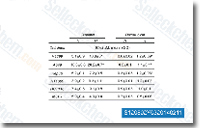
|
|
| S7306 | Dorsomorphin 2HCl | Dorsomorphin 2HCl is a potent, reversible, selective AMPK inhibitor with Ki of 109 nM in cell-free assays, exhibiting no significant inhibition of several structurally related kinases including ZAPK, SYK, PKCθ, PKA, and JAK3. Also inhibits type Ⅰ BMP receptor activity. Dorsomorphin induces autophagy in cancer cell line. |
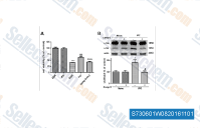
|
|
| S7840 | Dorsomorphin | Dorsomorphin is a potent, reversible, selective AMPK inhibitor with Ki of 109 nM in cell-free assays, exhibiting no significant inhibition of several structurally related kinases including ZAPK, SYK, PKCθ, PKA, and JAK3. Dorsomorphin selectively inhibits the BMP type I receptors ALK2, ALK3 and ALK6. Dorsomorphin is used in promoting specific cell differentiation and inducing cancer cell line autophagy. For cell testing, the water-soluble S7306 Dorsomorphin (Compound C) 2HCl is recommended. |
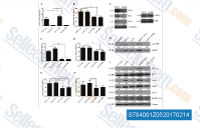
|
|
| S1802 | AICAR (Acadesine) | AICAR (Acadesine, NSC105823, AICA Riboside), an AMPK activator, results in accumulation of ZMP, which mimics the stimulating effect of AMP on AMPK and AMPK kinase. AICAR (Acadesine) induces mitophagy. Phase 3. |
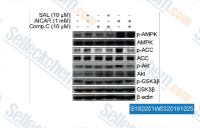
|
|
| S1033 | Nilotinib | Nilotinib is a selective Bcr-Abl inhibitor with IC50 less than 30 nM in Murine myeloid progenitor cells. Nilotinib induces autophagy through AMPK activition. |
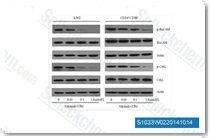
|
|
| S1113 | GSK690693 | GSK690693 is a pan-Akt inhibitor targeting Akt1/2/3 with IC50 of 2 nM/13 nM/9 nM in cell-free assays, also sensitive to the AGC kinase family: PKA, PrkX and PKC isozymes. GSK690693 also potently inhibits AMPK and DAPK3 from the CAMK family with IC50 of 50 nM and 81 nM, respectively. GSK690693 affects Unc-51-like autophagy activating kinase 1 (ULK1) activity, robustly inhibits STING-dependent IRF3 activation. Phase 1. |
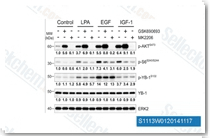
|
|
| S1950 | Metformin HCl | Metformin HCl (1,1-Dimethylbiguanide HCl) decreases hyperglycemia in hepatocytes primarily by suppressing glucose production by the liver (hepatic gluconeogenesis). Metformin promotes mitophagy in mononuclear cells. Metformin induces apoptosis of lung cancer cells through activating JNK/p38 MAPK pathway and GADD153. |
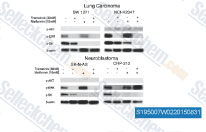
|
|
| S2697 | A-769662 | A-769662 is a potent, reversible AMPK activator with EC50 of 0.8 μM in cell-free assays, little effect on GPPase/FBPase activity. |
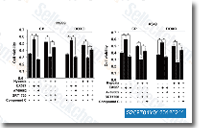
|
|
| S1396 | Resveratrol | Resveratrol has a wide spectrum of targets including cyclooxygenases(i.e. COX, IC50=1.1 μM), lipooxygenases(LOX, IC50=2.7 μM), kinases, sirtuins and other proteins. It has anti-cancer, anti-inflammatory, blood-sugar-lowering and other beneficial cardiovascular effects. Resveratrol induces mitophagy/autophagy and autophagy-dependent apoptosis. |
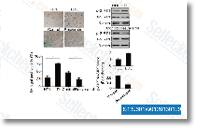
|
|
| S5958 | Metformin | Metformin (1,1-Dimethylbiguanide), a widely used drug for treatment of type 2 diabetes, activates AMP-activated protein kinase (AMPK) in hepatocytes. Metformin promotes mitophagy in mononuclear cells. Metformin induces apoptosis of lung cancer cells through activating JNK/p38 MAPK pathway and GADD153. | ||
| S8274 | STO-609 | STO-609 is a specific inhibitor of the Ca2+/Calmodulin-dependent protein kinase kinase(CaM-KK) that inhibits the activities of recombinant CaM-KKα and CaM-KKβ isoforms, with Ki values of 80 and 15 ng/ml, respectively, and also inhibits their autophosphorylation activities. STO-609 inhibits AMPKK activity and inhibits autophagy. | ||
| S7898 | GSK621 | GSK621 is a specific and potent AMPK activator. |
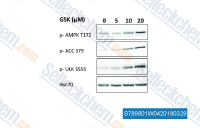
|
|
| S7317 | WZ4003 | WZ4003 is a highly specific NUAK kinase inhibitor with IC50 of 20 nM and 100 nM for NUAK1 and NUAK2 in cell-base assays, respectively, without significant inhibition on 139 other kinases. |

|
|
| S4895 | Nilotinib hydrochloride monohydrate | Nilotinib (AMN-107, Tasigna) hydrochloride monohydrate is a selective and orally bioavailable inhibitor of Bcr-Abl with IC50 < 30 nM in Murine myeloid progenitor cells. Nilotinib induces autophagy through AMPK activition. | ||
| S8654 | ex229 (compound 991) | EX229 (compound 991) is a potent AMPK activator that is 5-10-fold more potent than A769662 in activating AMPK. | ||
| S2542 | Phenformin HCl | Phenformin HCl is a hydrochloride salt of phenformin that is an anti-diabetic drug from the biguanide class. It activates AMPK, increasing activity and phosphorylation. |
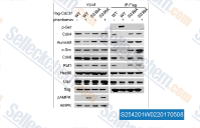
|
|
| S7318 | HTH-01-015 | HTH-01-015 is a potent and selective NUAK1 inhibitor with IC50 of 100 nM, >100-fold selectivity over NUAK2. |
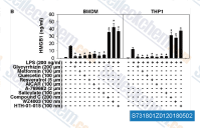
|
|
| S7953 | Bempedoic acid (ETC-1002) | Bempedoic acid (ETC-1002),also known as Bempedoic acid, is an orally available, once-daily LDL-C lowering small molecule designed to lower elevated levels of LDL-C and to avoid side effects associated with existing LDL-C lowering therapies.ETC-1002 is an activator of hepatic AMP-activated protein kinase (AMPK). It has potent inhibitory activity against hepatic ATP-citrate lyase(IC50=29 uM). | ||
| S8161 | ON123300 | ON123300 is a potent and multi-targeted kinase inhibitor with IC50 of 3.9 nM, 5 nM, 26 nM, 26 nM, 9.2 nM and 11nM for CDK4, Ark5/NUAK1, PDGFRβ, FGFR1, RET (c-RET), and Fyn, respectively. | ||
| S9833 | BAY-3827 | BAY-3827 is a potent AMPK inhibitor which inhibits AMPK kinase activity with IC50 values of 1.4 nM at a low, 10 μM ATP concentration and 15 nM at a high, 2 mM ATP concentration. | ||
| S3296 | Hispidulin | Hispidulin (Dinatin), an active natrual ingredient in a number of traditional Chinese medicinal herbs, exhibits inhibitory activity against the oncogenic protein kinase Pim-1 with IC50 of 2.71 μM. Hispidulin induces apoptosis through mitochondrial dysfunction and inhibition of P13k/Akt signalling pathway in HepG2 cancer cells. Hispidulin exerts anti-osteoporotic and bone resorption attenuating effects via activating the AMPK signaling pathway. | ||
| S0795 | O-304 | O-304 (O-304X) is an orally available pan-activator of AMPK activated protein kinase (AMPK). O-304 (O-304X) exhibits a great potential as a novel drug to treat type 2 diabetes (T2D) and associated cardiovascular complications. | ||
| S8803 | MK-3903 | MK-3903 is a potent and selective AMPK activator with an EC50 of 8 nM for α1 β1 γ1 subunit. It activates 10 of the 12 pAMPK complexes with EC50 values in the range of 8-40 nM and maximal activation >50%. | ||
| S0411 | BAM 15 | BAM 15 is a novel mitochondrial protonophore uncoupler capable of protecting mammals from acute renal ischemic-reperfusion injury and cold-induced microtubule damage. BAM 15 is also a potent AMPK activator. BAM 15 attenuates transportation-induced apoptosis in iPS-differentiated retinal tissue. | ||
| S4561 | Danthron | Danthron (Chrysazin, Antrapurol) functions in regulating glucose and lipid metabolism by activating AMPK. Danthron is a natural product extracted from the traditional Chinese medicine rhubarb. Danthron used to be a laxativa and now is currently used as an antioxidant in synthetic lubricants, in the synthesis of experimental antitumor agents, as a fungicide and as an intermediate for making dyes. | ||
| S5284 | Adenosine 5'-monophosphate monohydrate | Adenosine 5'-monophosphate monohydrate (5'-Adenylic acid, 5'-AMP) is an activator of a class of protein kinases known as AMP-activated protein kinase (AMPK). | ||
| S8335 | PF-06409577 | PF-06409577 is an orally bioavailable AMPK activator with EC50 of 7 nM for α1β1γ1 in the TR-FRET assay and it shows no detectable inhibition of hERG in a patch-clamp assay (100 μM) and was not an inhibitor (IC50 > 100 μM) of the microsomal activities of major human cytochrome P450 isoforms. | ||
| E1031 | MK-8722 | MK-8722 is a potent, direct, allosteric activator of all 12 mammalian pan-AMPK complexes. |
||
| E2032 | MOTS-c | MOTS-c, a mitochondria-derived peptide (MDP), exerts antinociceptive and anti-inflammatory effects through activating AMPK pathway and inhibiting MAP kinases-c-fos signaling pathway. | ||
| E3652 | Rehmanniae radix praeparata Extract | Rehmanniae radix praeparata Extract is extracted from Rehmanniae radix praeparata, which can improve diabetes through AMPK-mediated NF-κB/NLRP3 signaling pathway. | ||
| E2371 | YLF-466D | YLF-466D is an AMPK activator that inhibits platelet aggregation with IC50 of 84 μM. | ||
| S3832 | Euphorbiasteroid | Euphorbiasteroid (Euphorbia factor L1), a component of Euphorbia lathyris L., inhibits adipogenesis of 3T3-L1 cells through activation of the AMPK pathway and induces HL-60 cells to apoptosis via promoting Bcl-2/Bax apoptotic signaling pathway in a dose-dependent manner. Euphorbiasteroid is a tricyclic diperpene of Euphorbia lathyris L., inhibits tyrosinase, and increases the phosphorylation of AMPK, with anti-cancer, anti-virus, anti-obesity and multidrug resistance-modulating effect. | ||
| S8953 | ASP4132 | ASP4132 is a potent and orally active activator of Adenosine Monophosphate-Activated Protein Kinase (AMPK) with EC50 of 0.018 μM. ASP4132 is used as a clinical candidate for the treatment of human cancer. | ||
| E2818 | MARK4 inhibitor 1 | MARK4 inhibitor 1 is a potent microtubule affinity-regulating kinase 4 (MARK4) inhibitor, with an IC50 of 1.54 μM for MARK4 inhibition assay. | ||
| E0022 | Ophiopogonin D | Ophiopogonin D (OJV-VI, Deacetylophiopogonin C) is a steroidal glycoside isolated from Chinese herb Radix ophiopogonis and shows anti-tumor property. Ophiopogonin D could suppress TGF-β1-mediated metastatic behavior of MDA-MB-231 cells by regulating ITGB1/FAK/Src/AKT/β-catenin/MMP-9 signaling axis. Ophiopogonin D attenuates PM2.5-induced inflammation via suppressing the AMPK/NF-κB pathway in mouse pulmonary epithelial cells. | ||
| E0653 | Trans-ferulic acid | Trans-ferulic acid is a potent activator of AMPKunder high glucose condition. | ||
| E3041 | Alpiniae Katsumadai Extract | Alpiniae Katsumadai Extract is extracted from Alpiniae Katsumadai, which can induce growth inhibition and autophagy‑related apoptosis by regulating the AMPK and Akt/mTOR/p70S6K signaling pathways in cancer cells. | ||
| E0795 | COH-SR4 | COH-SR4 suppresses adipogenesis in 3T3-L1 cells through indirect activation of AMPK and downstream modulation of the Mammalian target of rapamycin complex 1 (mTORC1) signaling pathway, which blocks important regulators involved in protein synthesis, cell cycle progression, and expression of key transcription factors and their target adipogenic genes involved in lipid synthesis. | ||
| S3341 | Palmitoleic acid | Palmitoleic acid (POA, Palmitoleate) stimulates the uptake of glucose in liver through activation of AMPK and FGF-21, dependent on PPARα. |
||
| S9096 | ligustroflavone | Ligustroflavone (Nuezhenoside), isolated from the leaves of Turpinia montana, shows high antioxidant capacity and is reported to be an AMPK activator. | ||
| S0177 | XMD-17-51 | XMD-17-51 (XMD17-51) is a potent and highly selective inhibitor of NUAK1. | ||
| S2942 | EB-3D | EB-3D is a potent and selective inhibitor of choline kinase α (ChoKα) with IC50 of 1 μM for ChoKα1. EB-3D induces deregulation of the AMPK-mTOR pathway and apoptosis in leukemia T-cells. | ||
| S9860 | BC1618 | BC1618 is an orally active Fbxo48 inhibitor that stimulates adenosine monophosphate (AMP)-activated protein kinase (Ampk)-dependent signaling. BC1618 promotes mitochondrial fission, facilitates autophagy and improves hepatic insulin sensitivity. | ||
| S4460 | IMM-H007 | IMM-H007, an adenosine derivative, is an activator of AMP-Activated Protein Kinase (AMPK). IMM-H007 is a potential drug for treating cardiac dysfunction. IMM-H007 negatively regulates endothelium inflammation through inactivating NF-κB and JNK/AP1 signaling. IMM-H007 inhibits ABCA1 (ATP binding cassette subfamily a member 1) degradation and facilitates its cell-surface localization in macrophages, thereby promotes cholesterol efflux. | ||
| S9604 | Lixumistat (IM156) | Lixumistat (IM156), is a potent activator of AMPK that increases AMPK phosphorylation. IM156 blocks oxidative phosphorylation (OXPHOS) through the inhibition of complex I and increases apoptosis. IM156 ameliorates various types of fibrosis and inhibits tumors. | ||
| S9116 | Chikusetsusaponin IVa | Chikusetsusaponin IVa (Calenduloside F), a major active ingredient of triterpenoid saponins, has numerous pharmacological activities, including cytotoxic activity against various cancer cells, anti-inflammatory activity, prevention of dental caries and induction of genta-micin nephrotoxicity. Chikusetsusaponin IVa is a novel AMPK activator. | ||
| E0204 | Poricoic acid A | Poricoic acid A is isolated from the surface layer of Poria cocos. Poricoic acid A activates AMPK to attenuate fibroblast activation and abnormal extracellular matrix remodelling in renal fibrosis. Poricoic acid A also is a modulator of tryptophan hydroxylase-1 (TPH-1). | ||
| S0888 | Rsva 405 | Rsva 405, a novel small-molecule activator of AMPK, is a potent inhibitor of adipogenesis and thus may have therapeutic potential against obesity. | ||
| E2661 | Chitosan oligosaccharide | Chitosan oligosaccharide (COS) is an oligomer of β-(1➔4)-linked d-glucosamine, of which actions involve the modulation of several important pathways including the suppression of nuclear factor kappa B (NF-κB) and mitogen-activated protein kinases (MAPK) and the activation of AMP-activated protein kinase (AMPK). | ||
| S1323 | 7-Methoxyisoflavone | 7-Methoxyisoflavone (MIF) is a potent activator of adenosine monophosphate-activated protein kinase (AMPK). | ||
| S1321 | Urolithin B | Urolithin B inhibits NF-κB activity by reducing the phosphorylation and degradation of IκBα. Urolithin B suppresses the phosphorylation of JNK, ERK, and Akt, and enhances the phosphorylation of AMPK. Urolithin B is also a regulator of skeletal muscle mass. | ||
| E3011 | Sarsaparilla Extract | Sarsaparilla Extract is extracted from Smilax china L., which can stimulate 3T3-L1 Adipocytes to Brown-like Adipocytes Via β3-AR/AMPK Signaling Pathway. | ||
| S1273 | Amarogentin | Amarogentin (AG), a secoiridoid glycoside mainly extracted from Swertia and Gentiana roots, exhibits anti-oxidative, anti-tumour, and anti-diabetic activities. Amarogentin is an agonist for the bitter taste receptor TAS2R1 and inhibits in LAD-2 cells substance P-induced production of newly synthesized TNF-α. Amarogentin induces apoptosis in human gastric cancer cells (SNU-16) through G2/M cell cycle arrest and PI3K/Akt signalling pathway. Amarogentin (AG) interacts with the α2 subunit of AMP-activated protein kinase (AMPK) and activates the trimeric kinase with EC50 of 277 pM. |
||
| S6221 | Methyl cinnamate | Methyl cinnamate, an active component of Zanthoxylum armatum, is a widely used natural flavor compound with antimicrobial and tyrosinase inhibitor activities. Methyl Cinnamate Inhibits Adipocyte Differentiation via Activation of the CaMKK2--AMPK Pathway in 3T3-L1 Preadipocytes. | ||
| E3029 | White Paeony Root Extract | White Paeony Root Extract is extracted from Paeonia lactiflora Pall., which can alleviate liver injury in hypercholesterolemic rats through the ROCK/AMPK pathway. | ||
| E3032 | Atractyloides Macrocephala Root Extract | Atractyloides Macrocephala Root Extract is extracted from Atractylodes macrocephala Koidz., which can regulate lysophagy based on LKB1-AMPK-TFEB pathway. | ||
| S3299 | Demethyleneberberine | Demethyleneberberine (DMB), a component of Cortex Phellodendri Chinensis (CPC), significantly alleviates the weight loss and diminishes myeloperoxidase (MPO) activity, while significantly reduces the production of pro-inflammatory cytokines, such as interleukin (IL)-6 and tumor necrosis factor-α (TNF-α), and inhibits the activation of NF-κB signaling pathway. Demethyleneberberine (DMB) potentially ameliorates NAFLD (Non-alcoholic fatty liver disease) by activating AMPK pathways. | ||
| S1208 | Doxorubicin (DOX) HCl | Doxorubicin (DOX) HCl is an antibiotic agent that inhibits human DNA topoisomerase I and topoisomerase II with IC50s of 0.8 μM and 2.67 μM, respectively. Doxorubicin reduces basal phosphorylation of AMPK. Doxorubicin is used in the concomitant treatment of HIV-infected patients but is found to be at high risk of HBV reactivation.This product may precipitate when dissolved in PBS solution. It is recommended to prepare the stock solution in pure water and dilute with either pure water or saline to obtain the working solution.Doxorubicin (Adriamycin) HCl can be used to induce animal models of kidney disease. |

|
|
| S7306 | Dorsomorphin 2HCl | Dorsomorphin 2HCl is a potent, reversible, selective AMPK inhibitor with Ki of 109 nM in cell-free assays, exhibiting no significant inhibition of several structurally related kinases including ZAPK, SYK, PKCθ, PKA, and JAK3. Also inhibits type Ⅰ BMP receptor activity. Dorsomorphin induces autophagy in cancer cell line. |

|
|
| S7840 | Dorsomorphin | Dorsomorphin is a potent, reversible, selective AMPK inhibitor with Ki of 109 nM in cell-free assays, exhibiting no significant inhibition of several structurally related kinases including ZAPK, SYK, PKCθ, PKA, and JAK3. Dorsomorphin selectively inhibits the BMP type I receptors ALK2, ALK3 and ALK6. Dorsomorphin is used in promoting specific cell differentiation and inducing cancer cell line autophagy. For cell testing, the water-soluble S7306 Dorsomorphin (Compound C) 2HCl is recommended. |

|
|
| S1113 | GSK690693 | GSK690693 is a pan-Akt inhibitor targeting Akt1/2/3 with IC50 of 2 nM/13 nM/9 nM in cell-free assays, also sensitive to the AGC kinase family: PKA, PrkX and PKC isozymes. GSK690693 also potently inhibits AMPK and DAPK3 from the CAMK family with IC50 of 50 nM and 81 nM, respectively. GSK690693 affects Unc-51-like autophagy activating kinase 1 (ULK1) activity, robustly inhibits STING-dependent IRF3 activation. Phase 1. |

|
|
| S8274 | STO-609 | STO-609 is a specific inhibitor of the Ca2+/Calmodulin-dependent protein kinase kinase(CaM-KK) that inhibits the activities of recombinant CaM-KKα and CaM-KKβ isoforms, with Ki values of 80 and 15 ng/ml, respectively, and also inhibits their autophosphorylation activities. STO-609 inhibits AMPKK activity and inhibits autophagy. | ||
| S7317 | WZ4003 | WZ4003 is a highly specific NUAK kinase inhibitor with IC50 of 20 nM and 100 nM for NUAK1 and NUAK2 in cell-base assays, respectively, without significant inhibition on 139 other kinases. |

|
|
| S7318 | HTH-01-015 | HTH-01-015 is a potent and selective NUAK1 inhibitor with IC50 of 100 nM, >100-fold selectivity over NUAK2. |

|
|
| S8161 | ON123300 | ON123300 is a potent and multi-targeted kinase inhibitor with IC50 of 3.9 nM, 5 nM, 26 nM, 26 nM, 9.2 nM and 11nM for CDK4, Ark5/NUAK1, PDGFRβ, FGFR1, RET (c-RET), and Fyn, respectively. | ||
| S9833 | BAY-3827 | BAY-3827 is a potent AMPK inhibitor which inhibits AMPK kinase activity with IC50 values of 1.4 nM at a low, 10 μM ATP concentration and 15 nM at a high, 2 mM ATP concentration. | ||
| E3652 | Rehmanniae radix praeparata Extract | Rehmanniae radix praeparata Extract is extracted from Rehmanniae radix praeparata, which can improve diabetes through AMPK-mediated NF-κB/NLRP3 signaling pathway. | ||
| E2818 | MARK4 inhibitor 1 | MARK4 inhibitor 1 is a potent microtubule affinity-regulating kinase 4 (MARK4) inhibitor, with an IC50 of 1.54 μM for MARK4 inhibition assay. | ||
| E0022 | Ophiopogonin D | Ophiopogonin D (OJV-VI, Deacetylophiopogonin C) is a steroidal glycoside isolated from Chinese herb Radix ophiopogonis and shows anti-tumor property. Ophiopogonin D could suppress TGF-β1-mediated metastatic behavior of MDA-MB-231 cells by regulating ITGB1/FAK/Src/AKT/β-catenin/MMP-9 signaling axis. Ophiopogonin D attenuates PM2.5-induced inflammation via suppressing the AMPK/NF-κB pathway in mouse pulmonary epithelial cells. | ||
| S0177 | XMD-17-51 | XMD-17-51 (XMD17-51) is a potent and highly selective inhibitor of NUAK1. | ||
| E3029 | White Paeony Root Extract | White Paeony Root Extract is extracted from Paeonia lactiflora Pall., which can alleviate liver injury in hypercholesterolemic rats through the ROCK/AMPK pathway. | ||
| S1802 | AICAR (Acadesine) | AICAR (Acadesine, NSC105823, AICA Riboside), an AMPK activator, results in accumulation of ZMP, which mimics the stimulating effect of AMP on AMPK and AMPK kinase. AICAR (Acadesine) induces mitophagy. Phase 3. |

|
|
| S1033 | Nilotinib | Nilotinib is a selective Bcr-Abl inhibitor with IC50 less than 30 nM in Murine myeloid progenitor cells. Nilotinib induces autophagy through AMPK activition. |

|
|
| S1950 | Metformin HCl | Metformin HCl (1,1-Dimethylbiguanide HCl) decreases hyperglycemia in hepatocytes primarily by suppressing glucose production by the liver (hepatic gluconeogenesis). Metformin promotes mitophagy in mononuclear cells. Metformin induces apoptosis of lung cancer cells through activating JNK/p38 MAPK pathway and GADD153. |

|
|
| S2697 | A-769662 | A-769662 is a potent, reversible AMPK activator with EC50 of 0.8 μM in cell-free assays, little effect on GPPase/FBPase activity. |

|
|
| S1396 | Resveratrol | Resveratrol has a wide spectrum of targets including cyclooxygenases(i.e. COX, IC50=1.1 μM), lipooxygenases(LOX, IC50=2.7 μM), kinases, sirtuins and other proteins. It has anti-cancer, anti-inflammatory, blood-sugar-lowering and other beneficial cardiovascular effects. Resveratrol induces mitophagy/autophagy and autophagy-dependent apoptosis. |

|
|
| S5958 | Metformin | Metformin (1,1-Dimethylbiguanide), a widely used drug for treatment of type 2 diabetes, activates AMP-activated protein kinase (AMPK) in hepatocytes. Metformin promotes mitophagy in mononuclear cells. Metformin induces apoptosis of lung cancer cells through activating JNK/p38 MAPK pathway and GADD153. | ||
| S7898 | GSK621 | GSK621 is a specific and potent AMPK activator. |

|
|
| S4895 | Nilotinib hydrochloride monohydrate | Nilotinib (AMN-107, Tasigna) hydrochloride monohydrate is a selective and orally bioavailable inhibitor of Bcr-Abl with IC50 < 30 nM in Murine myeloid progenitor cells. Nilotinib induces autophagy through AMPK activition. | ||
| S8654 | ex229 (compound 991) | EX229 (compound 991) is a potent AMPK activator that is 5-10-fold more potent than A769662 in activating AMPK. | ||
| S2542 | Phenformin HCl | Phenformin HCl is a hydrochloride salt of phenformin that is an anti-diabetic drug from the biguanide class. It activates AMPK, increasing activity and phosphorylation. |

|
|
| S7953 | Bempedoic acid (ETC-1002) | Bempedoic acid (ETC-1002),also known as Bempedoic acid, is an orally available, once-daily LDL-C lowering small molecule designed to lower elevated levels of LDL-C and to avoid side effects associated with existing LDL-C lowering therapies.ETC-1002 is an activator of hepatic AMP-activated protein kinase (AMPK). It has potent inhibitory activity against hepatic ATP-citrate lyase(IC50=29 uM). | ||
| S3296 | Hispidulin | Hispidulin (Dinatin), an active natrual ingredient in a number of traditional Chinese medicinal herbs, exhibits inhibitory activity against the oncogenic protein kinase Pim-1 with IC50 of 2.71 μM. Hispidulin induces apoptosis through mitochondrial dysfunction and inhibition of P13k/Akt signalling pathway in HepG2 cancer cells. Hispidulin exerts anti-osteoporotic and bone resorption attenuating effects via activating the AMPK signaling pathway. | ||
| S0795 | O-304 | O-304 (O-304X) is an orally available pan-activator of AMPK activated protein kinase (AMPK). O-304 (O-304X) exhibits a great potential as a novel drug to treat type 2 diabetes (T2D) and associated cardiovascular complications. | ||
| S8803 | MK-3903 | MK-3903 is a potent and selective AMPK activator with an EC50 of 8 nM for α1 β1 γ1 subunit. It activates 10 of the 12 pAMPK complexes with EC50 values in the range of 8-40 nM and maximal activation >50%. | ||
| S0411 | BAM 15 | BAM 15 is a novel mitochondrial protonophore uncoupler capable of protecting mammals from acute renal ischemic-reperfusion injury and cold-induced microtubule damage. BAM 15 is also a potent AMPK activator. BAM 15 attenuates transportation-induced apoptosis in iPS-differentiated retinal tissue. | ||
| S4561 | Danthron | Danthron (Chrysazin, Antrapurol) functions in regulating glucose and lipid metabolism by activating AMPK. Danthron is a natural product extracted from the traditional Chinese medicine rhubarb. Danthron used to be a laxativa and now is currently used as an antioxidant in synthetic lubricants, in the synthesis of experimental antitumor agents, as a fungicide and as an intermediate for making dyes. | ||
| S5284 | Adenosine 5'-monophosphate monohydrate | Adenosine 5'-monophosphate monohydrate (5'-Adenylic acid, 5'-AMP) is an activator of a class of protein kinases known as AMP-activated protein kinase (AMPK). | ||
| S8335 | PF-06409577 | PF-06409577 is an orally bioavailable AMPK activator with EC50 of 7 nM for α1β1γ1 in the TR-FRET assay and it shows no detectable inhibition of hERG in a patch-clamp assay (100 μM) and was not an inhibitor (IC50 > 100 μM) of the microsomal activities of major human cytochrome P450 isoforms. | ||
| E1031 | MK-8722 | MK-8722 is a potent, direct, allosteric activator of all 12 mammalian pan-AMPK complexes. |
||
| E2032 | MOTS-c | MOTS-c, a mitochondria-derived peptide (MDP), exerts antinociceptive and anti-inflammatory effects through activating AMPK pathway and inhibiting MAP kinases-c-fos signaling pathway. | ||
| E2371 | YLF-466D | YLF-466D is an AMPK activator that inhibits platelet aggregation with IC50 of 84 μM. | ||
| S3832 | Euphorbiasteroid | Euphorbiasteroid (Euphorbia factor L1), a component of Euphorbia lathyris L., inhibits adipogenesis of 3T3-L1 cells through activation of the AMPK pathway and induces HL-60 cells to apoptosis via promoting Bcl-2/Bax apoptotic signaling pathway in a dose-dependent manner. Euphorbiasteroid is a tricyclic diperpene of Euphorbia lathyris L., inhibits tyrosinase, and increases the phosphorylation of AMPK, with anti-cancer, anti-virus, anti-obesity and multidrug resistance-modulating effect. | ||
| S8953 | ASP4132 | ASP4132 is a potent and orally active activator of Adenosine Monophosphate-Activated Protein Kinase (AMPK) with EC50 of 0.018 μM. ASP4132 is used as a clinical candidate for the treatment of human cancer. | ||
| E0653 | Trans-ferulic acid | Trans-ferulic acid is a potent activator of AMPKunder high glucose condition. | ||
| E0795 | COH-SR4 | COH-SR4 suppresses adipogenesis in 3T3-L1 cells through indirect activation of AMPK and downstream modulation of the Mammalian target of rapamycin complex 1 (mTORC1) signaling pathway, which blocks important regulators involved in protein synthesis, cell cycle progression, and expression of key transcription factors and their target adipogenic genes involved in lipid synthesis. | ||
| S3341 | Palmitoleic acid | Palmitoleic acid (POA, Palmitoleate) stimulates the uptake of glucose in liver through activation of AMPK and FGF-21, dependent on PPARα. |
||
| S9096 | ligustroflavone | Ligustroflavone (Nuezhenoside), isolated from the leaves of Turpinia montana, shows high antioxidant capacity and is reported to be an AMPK activator. | ||
| S2942 | EB-3D | EB-3D is a potent and selective inhibitor of choline kinase α (ChoKα) with IC50 of 1 μM for ChoKα1. EB-3D induces deregulation of the AMPK-mTOR pathway and apoptosis in leukemia T-cells. | ||
| S9860 | BC1618 | BC1618 is an orally active Fbxo48 inhibitor that stimulates adenosine monophosphate (AMP)-activated protein kinase (Ampk)-dependent signaling. BC1618 promotes mitochondrial fission, facilitates autophagy and improves hepatic insulin sensitivity. | ||
| S4460 | IMM-H007 | IMM-H007, an adenosine derivative, is an activator of AMP-Activated Protein Kinase (AMPK). IMM-H007 is a potential drug for treating cardiac dysfunction. IMM-H007 negatively regulates endothelium inflammation through inactivating NF-κB and JNK/AP1 signaling. IMM-H007 inhibits ABCA1 (ATP binding cassette subfamily a member 1) degradation and facilitates its cell-surface localization in macrophages, thereby promotes cholesterol efflux. | ||
| S9604 | Lixumistat (IM156) | Lixumistat (IM156), is a potent activator of AMPK that increases AMPK phosphorylation. IM156 blocks oxidative phosphorylation (OXPHOS) through the inhibition of complex I and increases apoptosis. IM156 ameliorates various types of fibrosis and inhibits tumors. | ||
| S9116 | Chikusetsusaponin IVa | Chikusetsusaponin IVa (Calenduloside F), a major active ingredient of triterpenoid saponins, has numerous pharmacological activities, including cytotoxic activity against various cancer cells, anti-inflammatory activity, prevention of dental caries and induction of genta-micin nephrotoxicity. Chikusetsusaponin IVa is a novel AMPK activator. | ||
| E0204 | Poricoic acid A | Poricoic acid A is isolated from the surface layer of Poria cocos. Poricoic acid A activates AMPK to attenuate fibroblast activation and abnormal extracellular matrix remodelling in renal fibrosis. Poricoic acid A also is a modulator of tryptophan hydroxylase-1 (TPH-1). | ||
| S0888 | Rsva 405 | Rsva 405, a novel small-molecule activator of AMPK, is a potent inhibitor of adipogenesis and thus may have therapeutic potential against obesity. | ||
| E2661 | Chitosan oligosaccharide | Chitosan oligosaccharide (COS) is an oligomer of β-(1➔4)-linked d-glucosamine, of which actions involve the modulation of several important pathways including the suppression of nuclear factor kappa B (NF-κB) and mitogen-activated protein kinases (MAPK) and the activation of AMP-activated protein kinase (AMPK). | ||
| S1323 | 7-Methoxyisoflavone | 7-Methoxyisoflavone (MIF) is a potent activator of adenosine monophosphate-activated protein kinase (AMPK). | ||
| S1321 | Urolithin B | Urolithin B inhibits NF-κB activity by reducing the phosphorylation and degradation of IκBα. Urolithin B suppresses the phosphorylation of JNK, ERK, and Akt, and enhances the phosphorylation of AMPK. Urolithin B is also a regulator of skeletal muscle mass. | ||
| E3011 | Sarsaparilla Extract | Sarsaparilla Extract is extracted from Smilax china L., which can stimulate 3T3-L1 Adipocytes to Brown-like Adipocytes Via β3-AR/AMPK Signaling Pathway. | ||
| S1273 | Amarogentin | Amarogentin (AG), a secoiridoid glycoside mainly extracted from Swertia and Gentiana roots, exhibits anti-oxidative, anti-tumour, and anti-diabetic activities. Amarogentin is an agonist for the bitter taste receptor TAS2R1 and inhibits in LAD-2 cells substance P-induced production of newly synthesized TNF-α. Amarogentin induces apoptosis in human gastric cancer cells (SNU-16) through G2/M cell cycle arrest and PI3K/Akt signalling pathway. Amarogentin (AG) interacts with the α2 subunit of AMP-activated protein kinase (AMPK) and activates the trimeric kinase with EC50 of 277 pM. |
||
| S6221 | Methyl cinnamate | Methyl cinnamate, an active component of Zanthoxylum armatum, is a widely used natural flavor compound with antimicrobial and tyrosinase inhibitor activities. Methyl Cinnamate Inhibits Adipocyte Differentiation via Activation of the CaMKK2--AMPK Pathway in 3T3-L1 Preadipocytes. | ||
| S3299 | Demethyleneberberine | Demethyleneberberine (DMB), a component of Cortex Phellodendri Chinensis (CPC), significantly alleviates the weight loss and diminishes myeloperoxidase (MPO) activity, while significantly reduces the production of pro-inflammatory cytokines, such as interleukin (IL)-6 and tumor necrosis factor-α (TNF-α), and inhibits the activation of NF-κB signaling pathway. Demethyleneberberine (DMB) potentially ameliorates NAFLD (Non-alcoholic fatty liver disease) by activating AMPK pathways. | ||
| E3032 | Atractyloides Macrocephala Root Extract | Atractyloides Macrocephala Root Extract is extracted from Atractylodes macrocephala Koidz., which can regulate lysophagy based on LKB1-AMPK-TFEB pathway. | ||
| E3041 | Alpiniae Katsumadai Extract | Alpiniae Katsumadai Extract is extracted from Alpiniae Katsumadai, which can induce growth inhibition and autophagy‑related apoptosis by regulating the AMPK and Akt/mTOR/p70S6K signaling pathways in cancer cells. |
Choose Selective AMPK Inhibitors
Tags: AMPK inhibition | AMPK activation | AMPK phosphorylation | AMPK activity | AMP-activated protein kinase pathway | AMPK activity assay | AMPK activators review | AMPK activity assay | AMPK inhibitor cancer | AMPK agonists | AMPK antagonist | AMPK inhibitor review







































